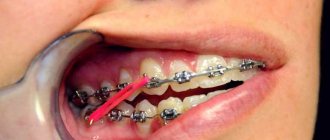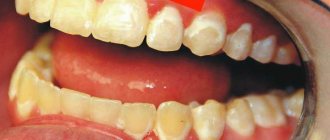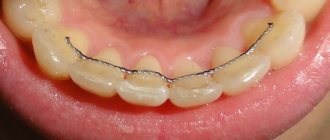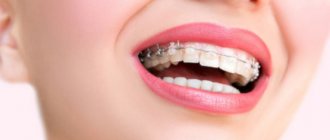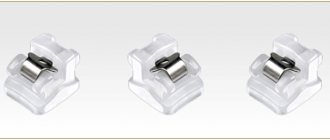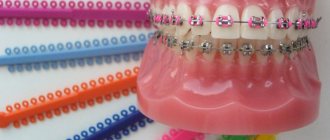2183
One of the best methods for eliminating abnormal bites is the use of braces in the treatment process.
But at the same time, after their removal, various defects appear on the surface enamel of the tooth. They can appear in the form of spots, and in some cases, carious cavities form.
Therefore, many patients have a question about how these negative consequences can be prevented and how to reduce the likelihood of their occurrence.
Whitening after braces
Interesting fact: in Ancient Egypt, there were a kind of braces - to straighten teeth, people wrapped animal intestines around them.
Many patients express their dissatisfaction when they see white spots on their teeth after braces. Their appearance may be due to the following reasons:
● frequent smoking;
● consumption of products containing dyes;
● insufficiently good oral hygiene.
In this case, bleaching should be carried out no earlier than a month after the removal of the structure. The enamel will have time to strengthen and recover, and the tone itself will even out. If you want to carry out the procedure, you can opt for Zoom or AirFlow cleanings - some of the most gentle options.
The effect of locking joints on teeth
The erroneous opinion that the locking connections of braces cause damage to the enamel surface causes a lot of prejudices, which are cited as arguments for reluctance to use orthodontic structures.
The clasps are attached to the teeth using a special adhesive. It eliminates contact with the enamel, since the existing gap is completely sealed. In addition, fluorine and other useful microelements are used in the glue, which creates an obstacle to the development of carious cavities.
Therefore, orthopedic structures to correct malocclusion do not cause damage to the color and integrity of the surface enamel. This is facilitated by the lack of proper hygienic care and the consumption of rough food during the period of use of the braces system.
Sometimes a violation of the integrity of tooth enamel becomes a consequence of poor-quality work by an orthodontist. In this case, food particles penetrate under the locks, which causes the growth of pathogenic microflora.
Important! To prevent mistakes when fixing a brace system, you need to take the right approach to choosing a dental clinic, inquire about its reputation and the qualifications of the specialists who practice there.
Excellent motivation for installing braces and ways to solve possible problems.
Come here if you are interested in the pros and cons of composite braces.
At this address https://orto-info.ru/sistemyi-vyiravnivaniya-zubov/breketyi/luchshe-postavit-posle-30-let.html we will discuss whether it is worth installing braces at 30 years old.
A retainer for teeth after braces can be:
● Removable (mouth guards, plates and trainers). Their advantage is that, if necessary, the structure can be removed for eating.
● Permanent. It looks like a splint or wire that is attached to the inner surface of the teeth with special glue.
In some cases, you must first wear a non-removable retainer, and then secure the result with a removable one.
Useful tips
In order to maintain the integrity of the surface enamel at the preliminary stage and during the treatment process with the braces system, it is necessary to adhere to the advice and recommendations prescribed by the orthodontist.
The need for medical procedures before fixation
After the initial examination and diagnosis, the orthodontist develops the course of the treatment process. At the same time, before installing the corrective system, much attention is paid to the preliminary stage.
In the course of it, the following problems are solved:
- Treatment of carious cavities and replacement of old fillings. Such therapeutic measures are necessary, since braces create an increased load on the teeth.
- Gum tissue diseases are treated. Installation of orthopedic products can aggravate even a minor inflammatory process (periodontitis, gingivitis or stomatitis).
- Elimination of tartar and soft plaque. For this purpose, a professional cleansing procedure is used using ultrasound or drugs containing fluoride compounds.
Dietary restrictions
Immediately after installing braces, you need to review the composition of your diet.
In this case, it would be ideal to eat the following foods:
- yoghurts and fruit jelly;
- puree of meat and vegetables;
- curd mass and porridge of liquid consistency.
Need to know! To prevent the process of demineralization when using an orthopedic structure, it is necessary to diversify the diet with foods that contain large amounts of calcium.
Restrictions associated with the consumption of solid foods will avoid damage to the orthopedic product and will also prevent the locking joints from coming off.
In addition, rough food can change the direction of the leveling forces of the structure. In this case, the dentition will move in the wrong direction, which will ultimately affect the course of treatment.
It is not recommended to consume the following products while wearing orthopedic products:
- corn and nuts, apples and drying;
- chips and popcorn, crackers and seeds.
Sticky foods (sweets, cheeses, dried fruits, soft bread) are especially dangerous. Its remains are difficult to remove, and their contact with bacterial microflora creates an acidic environment that prevents the entry of calcium and phosphates into the dental tissue.
Necessary procedures after removal
After removing the locking joints from the surface of the tooth, areas appear underneath them that retain their original shade.
In this regard, the following procedures are performed:
- Grinding of tooth enamel. For this purpose, polishing attachments are used, with the help of which the dentition is cleaned from residual adhesive composition. The use of a special paste based on calcium and fluorine allows you to remove foci of demineralization that occurs around braces.
- Use of remineralizing drugs. With deep fluoridation, a special composition is applied to the surface of the tooth, which allows its effect to be maintained for a long period of time.
What are bite fillings and for what purpose are they installed.
In this publication we will look at ways to fix braces.
Here https://orto-info.ru/sistemyi-vyiravnivaniya-zubov/breketyi/prohozhdenie-mrt.html we will find out whether it is possible to do an MRI with braces.
Restoring tooth enamel after braces
Demineralization of enamel after braces is a fairly common occurrence. If efforts are not made to combat it, serious problems may arise. The fluoridation procedure allows you to restore the enamel. There are several types:
● a procedure consisting of applying a special gel;
● local fluoridation with varnish;
● use of a retainer with a special composition inside.
The dentist can also suggest the most effective paste or other substance to reabsorb lost minerals.
Restorative techniques
Even if the patient correctly and regularly carries out hygienic care of the oral cavity after installing an orthopedic brace, after the treatment process, plaque and tartar remain on the enamel, and it loses its natural shade. Therefore, there are a number of dental procedures that will restore the original color.
Mechanical cleaning method
This technology is carried out using a special medical instrument (curette). The cleansing procedure is performed by a dentist, and only mineral deposits are removed.
Recently, the technique has lost its relevance due to the following reasons:
- during the procedure, there is a risk of damage to the surface coating of the tooth and gum tissue;
- takes a long period of time;
- accompanied by pain.
The method can be used if there are contraindications to other methods of cleansing. In some cases, manipulation is carried out using rotating brushes and special dental paste.
Laser whitening
The procedure is carried out using hydrogen peroxide. Activation of the therapeutic composition occurs under the influence of a laser emitter. By heating the plaque, moisture evaporates from it, which helps remove deposits from the enamel surface. The procedure has a number of advantages:
- takes no more than half an hour;
- high degree of quality of the final result;
- several sessions allow you to consolidate the whitening effect for several years;
- good prevention of caries;
- safety of the method.
A significant disadvantage of this technique is the presence of pain after the procedure, and an increased risk of disruption of metabolic processes in dentin.
Strengthening compounds
To strengthen tooth and gum tissue after wearing braces, it is allowed to use medications that contain vitamins and minerals.
In this case, the following drugs are prescribed:
- Asepta. The main ingredient is coral calcium. With systematic use over a period of one and a half months, dental tissue is restored.
- DentoVitus. It has a therapeutic effect due to the vitamin composition (C, A, E, B6) and such beneficial microelements as Copper, Fluorine, Calcium and Zinc, Silicon and Manganese.
- Rox. Plaque-preventing gel. Eliminates tooth sensitivity after removing braces.
- Kaltsinova. The optimized composition of minerals and vitamins increases the strength of dental tissue.
Application of special strips
This type of product whitens teeth due to its chemical composition. Each strip has three layers.
The surface and outer layers are made of thin plastic, the middle layer is impregnated with a special gel based on hydrogen peroxide. The oxidation process starts when the package is opened, and whitening occurs due to the deep penetration of the active substance into the dentin layer.
There are several types of whitening strips. For sensitive teeth, delicate strips are suitable. For normal ones, standard types of products are used. Strips with enhanced action allow you to restore the natural whiteness of teeth even in the case of a large accumulation of plaque.
It should be borne in mind that after removing braces, whitening strips can only be used after the remineralization procedure.
Composite restoration
If, after using corrective systems, procedures with a whitening effect do not produce positive results, then it is possible to use dental restoration using composite materials.
This technique has a number of the following advantages:
- speed of the procedure;
- achieving a high degree of aesthetic value;
- the procedure allows you to preserve healthy tissue;
- low cost.
A budget option for composite restoration are fillings made of acrylic, epoxies or photopolymers (the latter are considered universal and the most reliable).
Veneers
Stains after wearing braces can be hidden after installing veneers. They are thin plates that are fixed with adhesive to the front surface of the frontal incisors. This is a quick but expensive way to restore natural whiteness.
Microabrasion
This is a relatively new technique that allows you to get rid of white and age spots. For this purpose, a special abrasive mixture based on small particles of pumice and hydrochloric acid is used.
Using the grinding method, the dentist removes a thin layer of enamel (from 25 to 70 microns). This technique is effective if other treatment options do not lead to the desired effect. Also, its big advantage is the prevention of the development of caries at the initial stage.
In the video, the doctor will talk about how to strengthen and preserve enamel with braces.
Gentle method
This problem may have a simpler solution that does not require such radical measures, namely the most common hygienic action based on the use of AirFlow water-abrasive cleaning. Its use eliminates the negative impact on enamel, since it does not involve the use of aggressive chemicals. Many experts recommend performing this cleaning method first after removing the system, and if this option does not give the expected result, then after some time the issue of bleaching can be put on the agenda.
Your questions
Good afternoon Please tell me, is it worth putting braces on a child at 12 years old?
Please advise what is better – veneers or braces?
The question is: is it possible to do an MRI with braces?
I heard that there are braces that are only worn at night. Is it so?
This morning I saw that one of my braces had come off. What to do?
Hello! Tell me, is it necessary to remove a tooth with braces?
What recommendations and tips are there when wearing braces?
Tell me, do braces correct your bite?
Do installed braces affect diction?
Tell me, do they put braces on 1 jaw?
Dentist consultation
When planning an aesthetic restoration, the patient consultation begins with a photo session. Photographs help the doctor, together with the patient, visually analyze the defects. The patient voices his wishes, and the doctor talks about possible options for solving the problem. The doctor also takes several x-rays to clarify the diagnosis. Next, a treatment plan and estimate are drawn up.
The attending physician presented the patient with the following comprehensive treatment plan:
- Dental treatment with a microscope, replacing fillings in chewing teeth with ceramic inlays.
- Removal of a decayed tooth in the lower right.
- Dental implantation (lower “sixes”).
- Orthodontic teeth straightening.
- Teeth whitening.
- Aesthetic restoration (ceramic veneers and ceramic crowns on the front teeth) and prosthetics on implants to restore missing teeth.
For financial reasons, as well as due to lack of time for implantation, the patient asked to change the treatment plan and postpone the stage of restoration of the chewing teeth to a more favorable moment for her. Since the entire treatment process could be divided into several stages without loss for the patient, the doctors agreed to shorten the treatment plan and concentrated on restoring the aesthetics of the front teeth. The patient signed a waiver of full treatment.
Dial-Dent specialists who performed this work:
- Orthopedic dentist Tsukor S.V. — treatment planning, aesthetic dental prosthetics.
- Orthodontist Sleptsova M.P. — teeth straightening with braces.
- Dentist Borisova Yu.A. — dental treatment with a microscope.
- Dental technician Volk D.V. — production of ceramic crowns and ceramic veneers.
- Speech therapist Tsukor T.B. — sound pronunciation correction.
- Hygienist Smirnova E.P. — ZOOM teeth whitening.
- Dental assistants Kharlamova L., Antoshkina A.
See other examples of comprehensive solutions to dental problems here.
Advantages and disadvantages of whitening
The key advantage of the whitening procedure is manifested in a person’s beautiful snow-white smile. In addition, yellow teeth are not only not very beautiful, but also not very stable, and this is not only a problem with the appearance of the teeth. Whitening makes it possible to get rid of plaque and tartar, prevents the growth of bacteria in the oral cavity, and accordingly the risk of developing caries is reduced.
However, whitening also has disadvantages, in particular the likelihood of certain complications, which are not difficult to avoid; it is necessary to visit the dentist in a timely manner to diagnose the condition of the enamel.
To be or not to be wisdom teeth?
Pay attention to the partially cut “eights” (pictured). The Dial-Dent clinic pays considerable attention to the issue of treatment and, if necessary, removal of wisdom teeth.
Comment by the chief physician of the clinic S.V. Tsukora: “Removing the eighth teeth (especially the lower ones) is the most difficult removal of them all possible. It is fraught with a number of unpleasant phenomena and complications: loss of sensitivity along the nerve, difficulty opening the mouth, swelling, inflammation of the socket. Therefore, “eights” are not removed on purpose, without strict indications.
If there are indications, for example, caries, inflammation of the nerve in the eight (pulpitis), malocclusion, impaired closure of teeth, a gum pocket (hood above the eight), damage to the seventh from an incorrect eighth tooth, then a decision is made to remove it!
The tactics at Dial-Dent when removing figure eights are as follows: first, we remove wisdom teeth under anesthesia (sedation). It is not painful at all, not scary, there is no memory of the intervention. Second, we remove all problematic eights at once. I don’t understand the tactic of charging a month a month. Each time there may be swelling, pain, risk of complications, and each time it is possible to take antibiotics. For what?! I fell asleep, woke up - all my wisdom teeth were removed! After removal under sedation, the patient feels 100 times better than when it is done under local anesthesia.”
After analyzing the images, doctors decided not to remove wisdom teeth, since there is no indication for this. The girl is recommended to undergo regular preventive examinations to monitor the condition of her wisdom teeth.
Before starting complex treatment, the patient was recommended to remove the almost completely destroyed tooth from below, since it could not be restored.
The result of complex dental treatment
Results of complex dental treatment: all tasks were completed, the patient is satisfied with the result. It is recommended to undergo dental prosthetics in the near future to stabilize the results of teeth alignment. Without timely prosthetics, antagonist teeth, as well as teeth adjacent to the missing one, gradually shift, which can lead to problems with bite and diction.
As it turned out later, the girl postponed prosthetics for her chewing teeth for 10 years. It’s nice to look at the results of teeth restoration with veneers after 10 years - the veneers look just as good, they haven’t changed color, there are no chips. Fortunately, after 10 years the teeth did not move and the dental prosthetics were successful. Details here.
How to whiten teeth at home?
This may seem strange, but at home it is quite possible to get very good whitening results using the following techniques:
- the use of whitening gels, which give excellent and, very importantly, long-lasting results;
- the initial stage of tartar and plaque can be easily removed by regular brushing of the teeth and mouth, which should also include the use of dental floss and rinses;
- using herbal infusions, for example, sage leaves, which will have a beneficial effect on the condition of the gums.
Cleaning and whitening at home should be carried out with a high degree of accuracy and caution, because teeth have become more sensitive, and any aggressive impact can have the opposite effect on them than expected.
How to do whitening?
The teeth whitening procedure is one of the most effective and highly popular among dental patients. Its rather high cost is not the most pleasant moment, but the result obtained justifies all financial investments and costs.
When contacting a dentist with a similar problem, you can count on the following methods to solve the problem:
- hygienic cleaning with the help of which removes plaque and tartar, and also restores the natural color of the enamel;
- laser cleaning, which requires perfect cleanliness but gives excellent results;
- the use of special whitening strips that remove the yellow color of teeth and return them to their natural color.
Lemon
The ascorbic acid contained in lemon is beneficial not only for human gums, but also for the entire body. As for whitening with lemon, there are many options for this procedure, the simplest of which involves using one slice of a simple lemon to treat the enamel. Let’s also say a method based on adding a few drops of lemon juice to the toothpaste, which, by the way, will also help with bleeding gums.
Such products should be used carefully, no more than once a week; those who have increased tooth sensitivity should be especially careful.
Category Hygiene Published by Mister stomatolog

